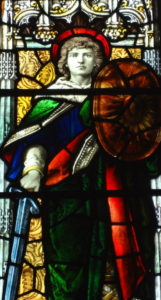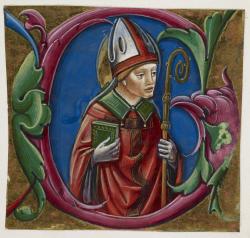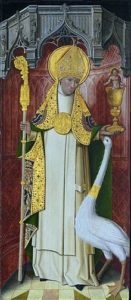St. Wistan, also known as Saint Wystan and Saint Wigstan, died in 840 A.D. His grandfather, King Wiglaf, ruled Mercia from 827 to 839. His father, Wigmund, died of dysentery shortly before him. A young Wistan may have been proclaimed king, but more likely he abdicated in favor of King Beorhtwulf (Bright Wolf), who ruled from 840 to 852. Wistan appointed his mother, Aelfaed, as regent. Wistan’s godfather, Beorhtric, son of King Beorhtwulf was appointed as her advisor. 
Wistan was scalped and slain with a blow to the head because he protested his widowed mother’s marriage to his godfather, Beorhtric. In canon law at that time, baptism established a link of spiritual consanguinity between the parents and godparents of the baptized. As a spiritually close relative, Wistan’s godfather was forbidden from marrying her.
Aelfaed was the daughter of King Ceolwulf of Mercia who ruled from 821-823, the last of an ancient Mercian royal line descended from Offa, a legendary warrior and ruler. The prestige of marriage to woman descended from the last branch of ancient Mercia was reason for Wistan’s murder. His death resulted from a Mercian power struggle between his family and that of his uncle Beorhtwulf and his son, Beorhtric. They may have inherited claims to the Midland kingdom from an earlier Mercian king, Beornwulf (823-825) or Beornred, who was deposed by Offa in 757.
There are various accounts of Wistan’s death on June 1, 840. Beorhtric cut off his head while he was standing in prayer. Beorhtric cut off the upper part of his head with is sword, while a companion stabbed him. Beorhtric struck Wistan on the head with the shaft of his dagger while his servant ran him through with a sword. Wistan’s companions were killed as well.
Most writers identify this spot with the village of Wistow in Leicestershire, although another candidate is Wistanstow in Shropshire. According to legend, the true site of Wistan’s murder was identified by a miraculous shaft of light, and an annual crop of human hair on the anniversary of his death. 
Miracles from heaven were not wanting in testimony of his martyrdom; for a column of light shot up to heaven from the spot where the innocent saint was murdered, and remained visible to the inhabitants of that place for 30 days. — Florence of Worcester
In 1077, Walter of Cerisy, the first Norman abbot of Evesham, subjected Wistan’s relics to the ordeal by fire. He was skeptical about the authenticity of Anglo-Saxon saints and relics. Since the fire had no effect on Wistan’s bones, the abbot decided to return St. Winstan’s relics to the shrine. By accident he dropped the saint’s head on the ground. It began to sweat and spread a sweet fragrance throughout the church.
The legend of the murder anniversary “crop of human hair” persisted for several hundred years. The miracle was apparently verified by a special commission set up by Archbishop Baldwin of Canterbury in 1187. 
St. Wistan’s relics disappeared during the Dissolution of the Monasteries under King Henry VIII between 1536-1541.
A detailed article about St. Wistan can be found on Clas Merdin, a good source for Arthurian legends.
“Conservation and the Catholic Imagination” was published by the Center for Humans and Nature in 2010. It was written by Marybeth Lorbiecki, director of Interfaith Oceans, an effort dedicated to awakening religious people to the need to restore and protect the world’s oceans. She is also the author of numerous books, including Following St. Francis: John Paul II’s Call for Ecological Action. 
Lorbiecki articulates an ethic that can not only help the environment, but also inspire and renew a new generation of Catholics.
“…. when the service-oriented imagination of Catholics has become engaged in a good cause, an enormous amount of work has gotten done—consider the creation of Catholic hospitals, hospices, schools for the poor, orphanages, and medical clinics that populate communities around the globe. So imagine the tipping point if even a small portion of this populace as a group could get publicly, physically, and passionately engaged in conservation works and activism.” 
“Now more than ever, this Catholic imagination is needed, not only to renew the world through activism, but for its own survival—for the inspiration to renew the Church itself. It needs a groundswell of new directions, new energies, and new ways to show meaningful, inspiring servant leadership in the world. Catholics are an untapped alternative energy source, and they need to be invited to the conservation table to participate not just as humans and fellow planetary citizens—as many are already involved for these reasons—but also specifically as Catholics. Presently, ecological teachings have been perceived as sideline issues rather than as core to whom Catholics are and dream themselves to be.”
Read the entire article here. I thought it was the best article I have ever read on Catholics and the environment.

The son of a noble, Hugh was a monk at La Grande Chartreuse in France when King Henry II of England asked him to come to Witham, England to head up a new Carthusian house. The house was founded by Henry II in reparation for his role in the death of Saint Thomas Becket. Hugh was a good man and a tough one. He insisted the king pay the residents who had been displaced from their homes on the property intended for the new monastery. He supported people when they suffered from the treatment by the king’s foresters. He stood down an angry mob determined to punish Jews. He convinced them to release their victims.
Nevertheless, the affable Hugh became a favorite of the king. In 1186 he was appointed bishop of Lincoln, the largest diocese in England. Shortly after his election, during his first visit to the manor in Stowe, Hugh was presented with a large wild swan that had recently come to the manor lake. Hugh offered the swan scraps of bread, and from that moment, the swan became devoted to him. When Hugh was away from the manor, the swan kept to the middle of the lake. But when the bishop came for a visit, the swan flew to him, tenderly placing his beak in the sleeve of the Hugh’s garment. If any of his attending clerics came near, the swan would jealously attack them. Their friendship lasted for 15 years. The swan lived a few years after Hugh, but never became close to another person. 
Antiquarian books often have the most charming stories and illuminating details. Here is one about St. Hugh from 100 years ago:
“St. Hugh as a Monk – Hugh grew up into a splendid young man, and he desired above all things to be a priest; so he was ordained and became a Carthusian monk in a monastery high up in the mountains. The monks lived a very austere life, fasting much, and never speaking to each other, living alone, each in his own cell. But for Hugh there were friends and companions with whom he might speak and yet keep his rule. He had always loved birds and beasts, and they knew it and loved him in return. When he sat down to supper his friends the birds would come hopping in, ready to share his meal; and the squirrels would scamper down from the trees and make themselves quite at home in his room, even whisking the food from his plate. Wherever he lived the wild creatures became his friends.” 
“St. Hugh as a Bishop – One day the prior of Hugh’s monastery received a letter from King Henry II of England asking for a good monk to take charge of a monastery…There was a lake in the grounds, and one day a splendid wild swan swooped down on it and killed or drove off all the tame ones, and then sounded a shrill cry of triumph. The servants knew how the Bishop loved wild creatures, and they managed to get the swan up to the palace; St. Hugh at once made friends with it, and coaxed it to eat bread from his hand, and the creature became devoted to him from that moment. It followed him everywhere, and even slept in his room. The servants dare not go near the bed when St. Hugh was asleep, for the great bird would raise its huge wings in defense and hiss fiercely. It would never let anyone but Hugh touch it, but it would nestle its head up his sleeve, and fondle him with queer loving cries. When the Bishop was away from Stow the swan never entered the palace, but it seemed to know when he was expected, and as soon as the luggage carts and servants began to arrive it would leave the lake and go striding up to the house. When it heard its master’s voice it would run to him and follow him about all the time he remained at Stow. But when St. Hugh came to Lincoln for the last time, just before his death, the swan seemed to know what was coming, and would not go near him, but hid in the reeds, drooping and ill, broken-hearted at losing his beloved master.” Faith & Duty by Judith F. Smith, Benzinger Bros., 1920









